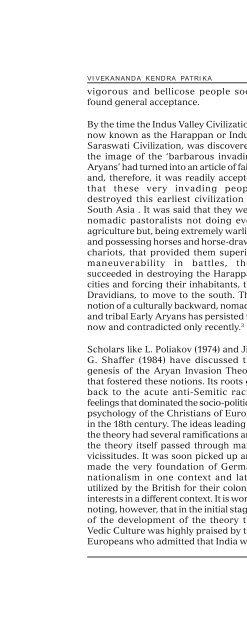Aryan Invasion Theory - Publication - Vivekananda Kendra
Aryan Invasion Theory - Publication - Vivekananda Kendra
Aryan Invasion Theory - Publication - Vivekananda Kendra
You also want an ePaper? Increase the reach of your titles
YUMPU automatically turns print PDFs into web optimized ePapers that Google loves.
VIVEKANANDA KENDRA PATRIKA<br />
vigorous and bellicose people soon<br />
found general acceptance.<br />
By the time the Indus Valley Civilization,<br />
now known as the Harappan or Indus-<br />
Saraswati Civilization, was discovered,<br />
the image of the ‘barbarous invading<br />
<strong>Aryan</strong>s’ had turned into an article of faith<br />
and, therefore, it was readily accepted<br />
that these very invading people<br />
destroyed this earliest civilization of<br />
South Asia . It was said that they were<br />
nomadic pastoralists not doing even<br />
agriculture but, being extremely warlike<br />
and possessing horses and horse-drawn<br />
chariots, that provided them superior<br />
maneuverability in battles, they<br />
succeeded in destroying the Harappan<br />
cities and forcing their inhabitants, the<br />
Dravidians, to move to the south. This<br />
notion of a culturally backward, nomadic<br />
and tribal Early <strong>Aryan</strong>s has persisted till<br />
now and contradicted only recently. 3<br />
Scholars like L. Poliakov (1974) and Jim<br />
G. Shaffer (1984) have discussed the<br />
genesis of the <strong>Aryan</strong> <strong>Invasion</strong> <strong>Theory</strong><br />
that fostered these notions. Its roots go<br />
back to the acute anti-Semitic racial<br />
feelings that dominated the socio-political<br />
psychology of the Christians of Europe<br />
in the 18th century. The ideas leading to<br />
the theory had several ramifications and<br />
the theory itself passed through many<br />
vicissitudes. It was soon picked up and<br />
made the very foundation of German<br />
nationalism in one context and later<br />
utilized by the British for their colonial<br />
interests in a different context. It is worth<br />
noting, however, that in the initial stages<br />
of the development of the theory the<br />
Vedic Culture was highly praised by the<br />
Europeans who admitted that India was<br />
13<br />
ARYAN INVASION THEORY<br />
the original home of the entire human<br />
race and the cradle of civilization.<br />
Many scholars like Kant and Herder<br />
delighted in showing analogies between<br />
the myths and philosophies of ancient<br />
India and the West. Voltaire was<br />
‘convinced that everything has come<br />
down to us from the banks of the Ganges<br />
, astronomy, astrology, metempsychosis,<br />
etc.’ (Voltaire quoted in Poliakov<br />
1974:185). Giving these and other<br />
examples, Poliakov (1974:188) concludes:<br />
‘Thus we see that a wide variety of<br />
authors and schools located the<br />
birthplace of the entire human race<br />
between the Indus and the Ganges ‘. This<br />
high esteem for India and its culture in<br />
the minds of the European scholars may<br />
have developed partly because of their<br />
anti-Semitic feelings 4 , but the fact<br />
remains that the image of Vedic <strong>Aryan</strong>s<br />
was tarnished only in a subsequent<br />
version of the theory.<br />
The new incarnation of the theory was<br />
quite different from the original one. It<br />
was not concerned with the origin and<br />
expansion of the whole human race but<br />
one particular white race, whose<br />
descendants are the modern Christians<br />
of Europe. It owes its origin to Sir<br />
William Jones’ famous lecture delivered<br />
at the Asiatic Society of Bengal in 1786.<br />
How this lecture led to the foundation of<br />
comparative philology that aimed at<br />
dethroning Vedic Sanskrit from the high<br />
pedestal, that it previously occupied, is<br />
too well known to be repeated here. The<br />
old linguistic perspective is being still kept<br />
alive by some scholars but to this I shall<br />
come back a little later.

















